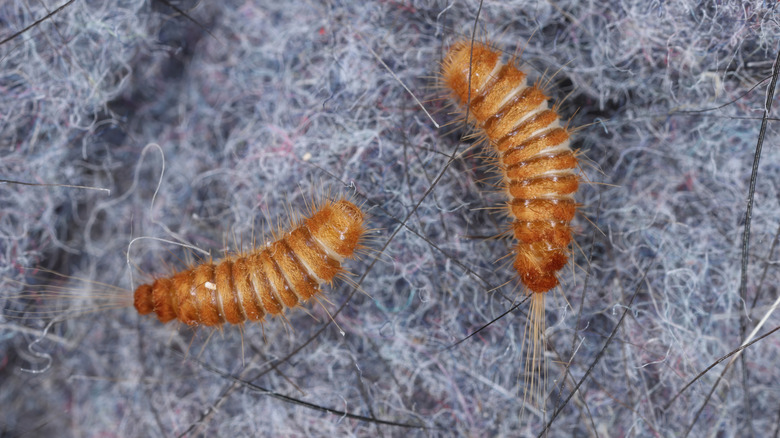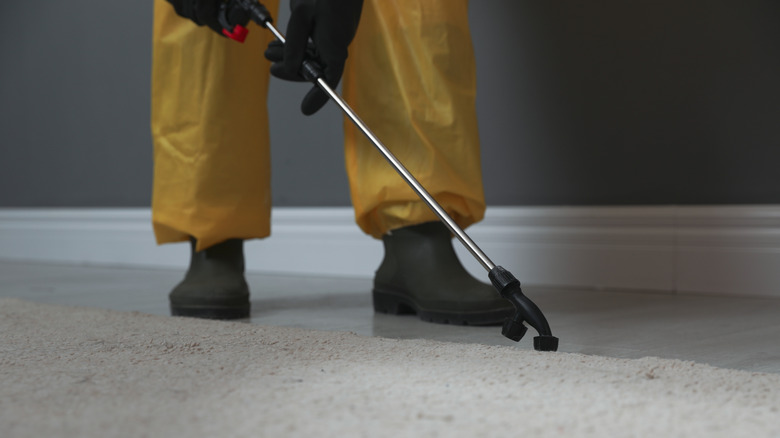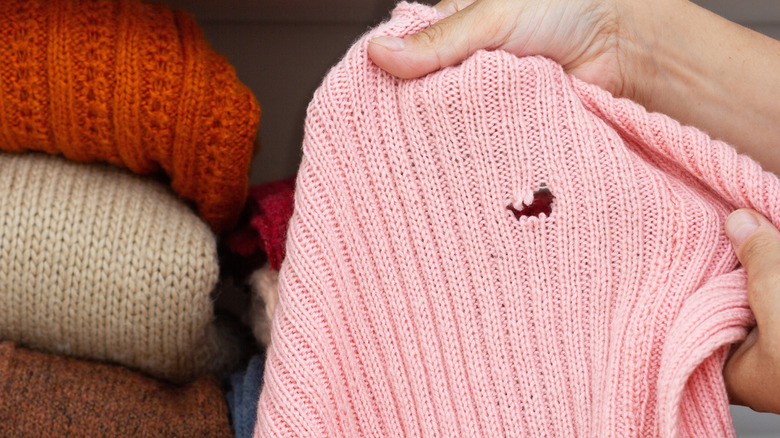Are Those Brown Spots Carpet Beetle Larvae? Here's How To Identify Them
Have you noticed brown spots in your carpet? If you have no idea where they came from, carpet beetle larvae could be the culprit. It's important to identify the signs as soon as possible so that you can get rid of the infestation before it worsens. While speaking exclusively to House Digest, Dr. Jim Fredericks, a board-certified entomologist and senior vice president of public affairs at the National Pest Management Association (NPMA), revealed the signs of a carpet beetle infestation you can look for to determine whether those brown spots on your carpet are larvae.
According to the expert, they will look like 1/4-inch-long brownish ovals that appear wider toward the end. "Larvae are brown or tan color and are covered in tiny, bristle-like hairs, making them look fuzzy," Dr. Fredericks explained. You should look out for signs of damage as well. "The carpet beetle is a common household pest whose larvae are known for damaging fabrics and natural fibers, rugs, and food," the expert shared. The pests can even leave irregular holes in clothes made of natural fibers. The growth process of carpet beetle larvae can make it easier to identify them as well. "As larvae grow, they molt and leave behind fuzzy, translucent skins which might look like little pieces of lint," added Dr. Fredericks.
Finding and eliminating carpet beetle larvae
Certain environments are more appealing to carpet beetle larvae than others. "Carpet beetle larvae love dark, undisturbed areas — like attics and closets — where they can easily find food," Dr. Jim Fredericks said while speaking exclusively to House Digest. "In addition, larvae thrive on natural-fiber carpets and rugs since they feed on natural fibers or animal-based materials like wool."
These pests eat what they find in carpet and around furniture cushions, such as pet hair. They also consume dead insects inside of wall voids. "This often occurs following an infestation of overwintering pests like multicolored Asian lady beetles, brown marmorated stink bugs, or boxelder bugs," Dr. Fredericks shared. If you have animal hides or hunting trophies displayed in your home, you should know that carpet beetle larvae may feed on them as well, causing damage.
There's no need to panic if you discover a carpet beetle larvae infestation in your home. According to our expert entomologist, you should contact a licensed pest control professional who will use specialized treatment to tackle the problem. It's also important to keep your home clean so that it's an unpleasant environment for the pests. This should include vacuuming carpets and upholstery, being careful to not neglect carpeted corners or areas underneath furniture.
Carpet beetle larvae can cause severe damage
Do not underestimate the damage carpet beetle larvae can cause. "Carpet beetle larvae are small but can cause significant problems if left unchecked," Dr. Jim Fredericks shared during our exclusive chat. "Prompt removal is essential to preventing damage to your home and belongings." Along with natural fibers, these pests also feed on stored food. They leave fecal pellets and shed skin inside of food packaging once they get in. This means that the larvae are also a threat to your food supply, which is yet another reason to keep carpet beetles out of your house.
If you have an infestation, consider storing all food in your refrigerator until it is resolved. Additionally, you can protect your clothes by storing them in plastic containers. "Dry-clean clothing thoroughly before storing for long periods of time," Dr. Fredericks added.
Keep garments and soft surfaces clean to repel carpet beetle larvae, too. "Clean fabrics promptly, as items that have been soiled with sweat or food spills are especially attractive to carpet beetles," the expert advised. If you think you might have carpet beetle larvae in your home, call a professional rather than attempting to tackle the problem yourself. That way, you do not have to worry about dealing with the damage long term. "They can also provide advice on how to prevent carpet beetles from returning, including identifying entry points that they may have come through," Dr. Fredericks shared.


